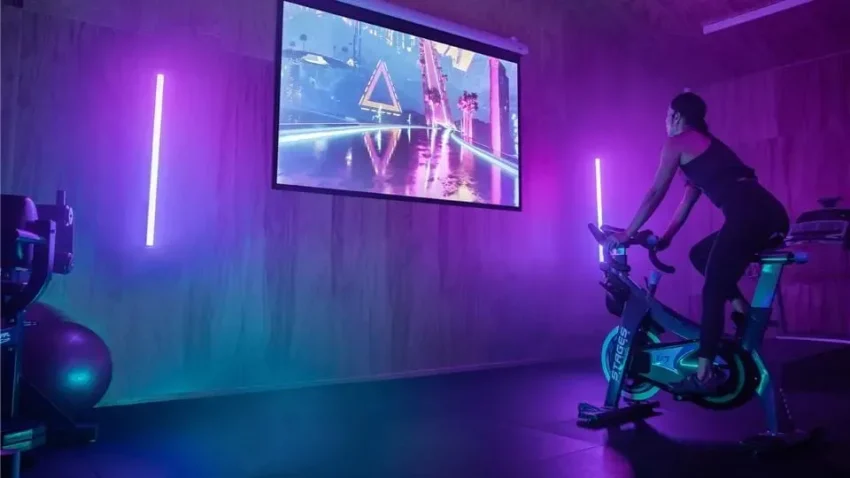Future of Fitness: Trends to Watch in 2024
The Future of Fitness is brimming with innovative possibilities that aim to revolutionize how we engage with our health and wellness. As we move into 2024, emerging fitness trends are set to reshape our routines, emphasizing the integration of technology in fitness, community-driven experiences, and holistic wellness approaches. The rise of functional fitness practices will cater to a broader audience, ensuring accessibility for all, while technology enhances the personalization of workouts. Moreover, a focus on mental well-being alongside physical fitness will transform traditional gym experiences into holistic wellness journeys. This exciting evolution hints at not just a shift in our fitness practices, but a profound change in how we perceive health itself.
As we look ahead, the landscape of physical activity is witnessing a remarkable transformation often referred to as the future of health and fitness. This new era is characterized by a merging of digital innovations, community engagement, and comprehensive wellness philosophies. Interest in trends like functional movement training is surging, highlighting a shift towards exercises that promote everyday functionality. At the same time, the integration of mental health principles into fitness routines reflects a broader understanding of well-being. By embracing these concepts, individuals can expect more personalized, engaging, and inclusive approaches to their fitness journeys.
Technology Integration in Fitness
The rise of wearable technology has been a game-changer in the fitness landscape, transforming how individuals track their health metrics. Companies such as Fitbit and Garmin are continually innovating to provide features that allow users to monitor everything from sleep patterns to caloric intake. This technology empowers fitness enthusiasts to personalizes their workouts and overall wellness approach by offering precise data that can be correlated with performance and recovery. As advancements continue, functionalities like blood glucose monitoring and hydration tracking are expected to become standard, paving the way for a more insightful fitness journey.
Moreover, these devices not only facilitate personal fitness tracking but also foster community connectivity. Users can engage in challenges, compare their progress with friends, and share achievements on social media platforms, thus enhancing the overall motivation to maintain a healthy lifestyle. This shift in how technology is integrated into fitness encourages a collaborative spirit, where individuals can support one another in achieving their health and fitness goals.
Virtual Reality and Augmented Reality in Fitness
The application of virtual and augmented reality in fitness presents an innovative way to enhance workout experiences. With programs like Supernatural and FitXR, users find themselves transported into immersive environments where exercise is integrated with entertainment. This not only boosts motivation but also addresses the common issue of workout monotony. By incorporating AR and VR, workouts become more engaging and enjoyable, particularly for younger demographics such as Gen Z and Millennials who are already accustomed to interactive technology.
As fitness organizations embrace these technologies, we will likely see a rise in specialized classes that leverage these systems for a dynamic workout experience. This trend toward gamified fitness solutions allows individuals to personalize their fitness journeys further, as they can select environments and challenges that excite them, ultimately leading to a greater commitment to their fitness goals.
AI Personal Trainers: The Future of Fitness Coaching
Artificial intelligence is redefining the landscape of personal training by providing users with customized fitness experiences tailored to their specific goals. Applications employing AI algorithms, such as Freeletics, analyze user performance in real-time to adjust workout plans dynamically. This technology reduces the guesswork associated with traditional fitness programs, offering a streamlined approach to achieving health and strength milestones.
Additionally, AI personal trainers can enhance user engagement by providing timely feedback and motivational reminders that keep fitness enthusiasts accountable. As these technologies advance, we can expect even more sophisticated and responsive programs that not only acknowledge physical fitness but also integrate aspects of mental wellness, supporting a holistic approach to health.
Hybrid Fitness Models: Blending Online and In-Person Workouts
The rise of hybrid fitness models has revolutionized how individuals engage with exercise routines. Post-pandemic, many have realized the benefits of combining both online and in-person classes, allowing flexibility and convenience in their busy lives. For example, platforms like Peloton offer live and on-demand classes that cater to various schedules, ensuring that users can fit workouts into their day, no matter where they are.
This blending of experiences not only fosters community engagement but also helps individuals form connections with peers, which is vital for maintaining motivation. The upcoming trends in 2024 are likely to see more facilities adopting hybrid models, recognizing that modern fitness enthusiasts seek adaptability and connection in their wellness journeys.
Social Fitness: Enhancing Engagement Through Community
Social fitness is becoming an integral part of workout culture, emphasizing the importance of building connections through shared experiences. Fitness apps are increasingly incorporating features that allow users to engage with one another, participate in group challenges, and celebrate each other’s milestones. This trend counters the often isolating nature of traditional workout routines, providing a social structure that encourages accountability and motivation.
Moreover, social fitness communities foster a sense of belonging, which can be especially beneficial for individuals who might struggle with motivation alone. The communal approach not only makes workouts more enjoyable but also aids in building lasting relationships that extend beyond the gym, highlighting fitness as a collective journey.
Holistic Wellness Approaches in Fitness
Holistic wellness is emerging as a vital focus in fitness, merging the realms of physical health with mental well-being. The increasing recognition of the mind-body connection underscores the need for programs that incorporate mindfulness practices such as yoga and meditation into regular fitness routines. Gyms are beginning to offer classes that promote mental wellness, encouraging participants to engage with both their physical and mental health.
By embracing this comprehensive perspective, fitness programs aim to combat stress and anxiety while fostering a healthier lifestyle overall. As this trend continues to grow in 2024, more centers will integrate mental health initiatives into their offerings, ensuring that wellness goes beyond mere physical activity.
The Role of Nutrition in Comprehensive Wellness
Nutrition is a critical component of comprehensive wellness, and many fitness centers are recognizing its role alongside physical activity. In 2024, expect to see increased integration of nutritional guidance into personal training programs, allowing clients to align their dietary choices with their fitness goals. Services might range from nutritional counselling to meal prep workshops, all designed to educate individuals on the importance of proper nutrition for both physical performance and mental clarity.
Understanding that nutrition plays a significant part in overall health can encourage more people to invest in wellness beyond their workouts. As comprehensive wellness programs gain traction, the integration of nutrition, fitness, and mental well-being will cultivate a well-rounded approach to health, helping individuals achieve more sustainable results.
Functional Fitness: Catering to All Ages
Functional fitness is increasingly being recognized as essential, especially for older adults who require exercise forms that enhance daily living capabilities. This training style is focused on movements that replicate daily activities, promoting balance, strength, and flexibility. As the population ages, gyms are adapting their offerings to include functional training, ensuring that seniors can maintain independence and quality of life.
This approach not only benefits older adults but also creates opportunities for younger individuals to engage with fitness in a way that mimics real-life situations. As functional training becomes more mainstream, it reinforces the idea that fitness should cater to all age groups and levels of ability, emphasizing empowerment rather than exclusion.
Accessibility in Fitness: Breaking Down Barriers
Accessibility in fitness is gaining much attention as facilities strive to create environments that welcome individuals regardless of their abilities. Many gyms are now redesigning their spaces and offering specialized classes to ensure that everyone, including those with disabilities, can participate in fitness programs. This trend signifies a critical shift towards inclusivity within the fitness industry, emphasizing that health and wellness are universal rights.
Moreover, as awareness of accessibility issues grows, there is a burgeoning demand for fitness equipment and programs specifically designed for those with varying needs. By prioritizing accessibility, the fitness industry can break down barriers and create opportunities for all individuals to embark on their wellness journeys.
Sustainable Practices in Fitness Industries
The emphasis on sustainability within fitness is a trend that mirrors broader societal movements toward eco-conscious practices. Gyms and wellness studios are increasingly adopting eco-friendly measures, including using recycled materials for construction and endorsing sustainable products. This trend reflects a deeper understanding within the fitness community of the importance of caring for the planet alongside personal health.
Additionally, consumers are becoming more passionate about supporting brands that prioritize sustainability, notably in apparel and equipment. Companies are responding by harnessing innovations in eco-friendly materials and manufacturing processes. As the fitness industry shifts towards greener initiatives, it aligns closely with the growing consumer desire to live healthily, both for themselves and the environment.
Frequently Asked Questions
What are the emerging fitness trends to watch for in the future of fitness?
In the future of fitness, trends like wearable technology, virtual reality workouts, AI personal trainers, and hybrid fitness models are gaining momentum. These innovations enhance user experience, personalize fitness journeys, and foster community engagement.
How is technology influencing the future of fitness?
Technology plays a pivotal role in the future of fitness by integrating advanced wearables, AI-driven coaching apps, and immersive virtual workouts. These advancements facilitate personalized training, improve health insights, and enhance overall engagement in fitness routines.
What are community-oriented approaches in the future of fitness?
Community-oriented approaches, such as social fitness apps and hybrid workout models, are essential in the future of fitness. They encourage connection among participants, blending online and in-person experiences to foster motivation and collaboration.
How will holistic wellness be integrated into future fitness programs?
The future of fitness emphasizes holistic wellness by incorporating mental health practices like mindfulness and meditation alongside physical workouts. This comprehensive approach supports overall well-being, recognizing the vital mind-body connection.
What role will functional fitness play in the future, especially for older adults?
Functional fitness will become increasingly important for older adults in the future of fitness, focusing on exercises that enhance mobility, balance, and strength, helping seniors maintain independence and improve their quality of life.
What is the significance of AI personal trainers in the future of fitness?
AI personal trainers represent a key trend in the future of fitness, offering personalized workout plans and adaptive coaching. This technology enhances individual engagement and effectiveness by tailoring fitness regimens to user preferences and progress.
How are fitness brands embracing sustainability in the future of fitness?
Fitness brands are embracing sustainability by creating eco-friendly products, utilizing sustainable materials, and promoting practices that minimize environmental impact. This trend aligns consumer values with fitness choices, influencing purchasing decisions.
What is social fitness and its impact on the future of fitness?
Social fitness refers to the rise of group activities and fitness challenges that enhance user engagement. This trend in the future of fitness fosters camaraderie, motivation, and accountability among participants, making workouts more enjoyable.
How will hybrid fitness models shape the future of fitness?
Hybrid fitness models, blending online and in-person workouts, will shape the future of fitness by providing flexibility and accessibility. This approach allows individuals to participate in fitness from the comfort of their homes while staying connected to a community.
Why is prioritizing accessibility important in the future of fitness?
Prioritizing accessibility in the future of fitness ensures that individuals of all abilities, including those with disabilities and older adults, have equal access to fitness opportunities. This commitment fosters inclusivity and supports diverse fitness journeys.
| Trend | Description |
|---|---|
| Technology Integration in Fitness | Involves wearable technology, VR/AR workouts, and AI personal trainers to enhance user experience and personalization. |
| Community-Oriented and Hybrid Workouts | Focuses on hybrid fitness models and social fitness activities for a connected and engaging workout experience. |
| Holistic and Mental Wellness Approaches | Emphasizes integration of mental wellness into fitness programs and offers comprehensive wellness coaching. |
| Functional Fitness and Accessibility for Older Adults | Highlights the importance of functional training tailored for older adults, along with increased accessibility in fitness facilities. |
| Sustainability and Eco-Friendly Practices | Encourages eco-friendly practices in gyms and promotes sustainable fitness apparel to align with environmental values. |
Summary
The Future of Fitness is rapidly evolving and poised for significant changes in 2024. The confluence of advanced technologies, a focus on community, and a commitment to holistic and sustainable wellness will redefine our fitness journeys. This evolution signifies a shift towards personalization and inclusivity, enabling individuals to pursue fitness in a way that aligns with their unique lifestyles and values. As these trends emerge, they open doors to a more engaging, accessible, and health-conscious approach to fitness, focusing on overall well-being rather than just physical appearance. Embracing the Future of Fitness means participating in a movement that values health, connection, and sustainability for a better tomorrow.
#FutureOfFitness #FitnessTrends2024 #HealthInnovation #WellnessTech #NextGenFitness








